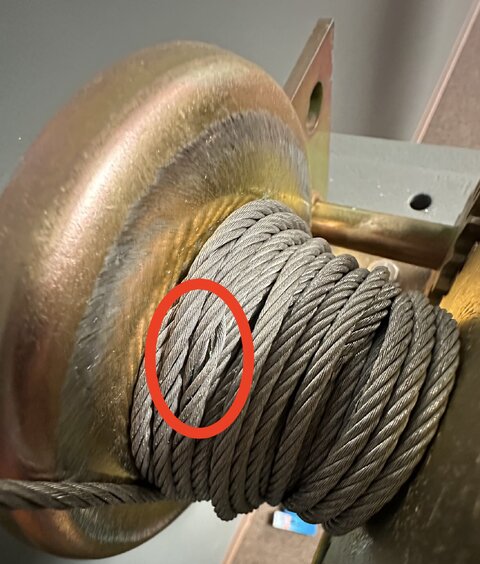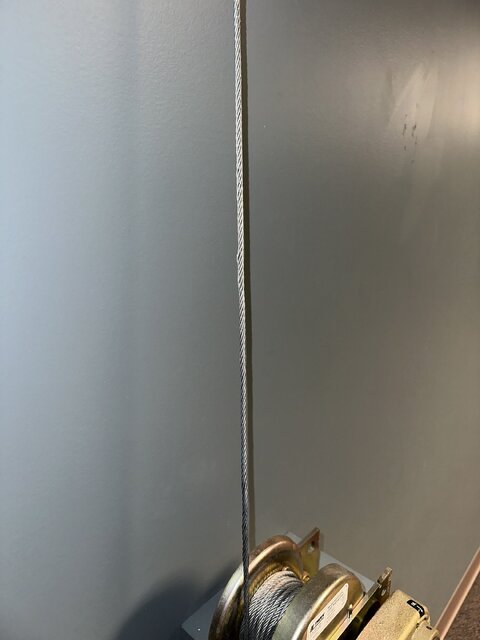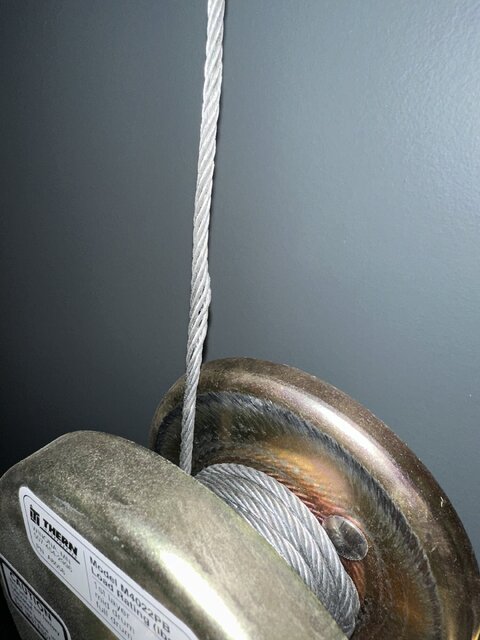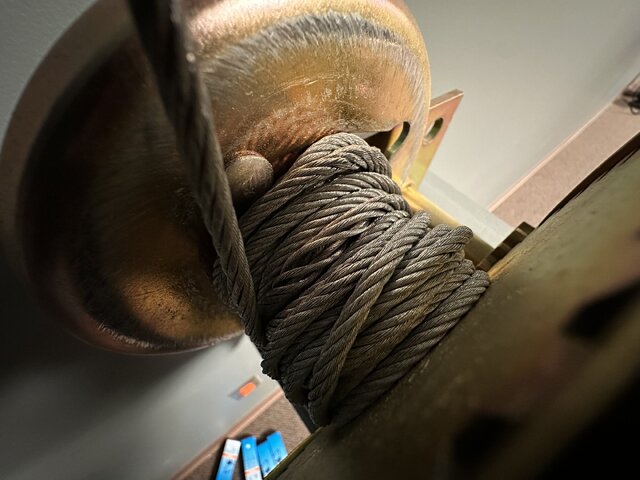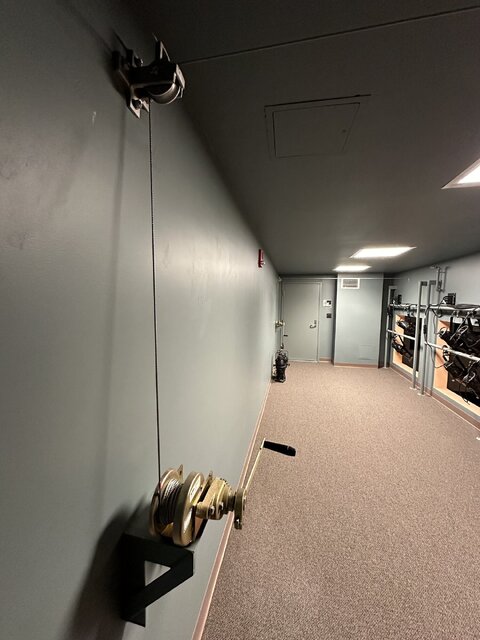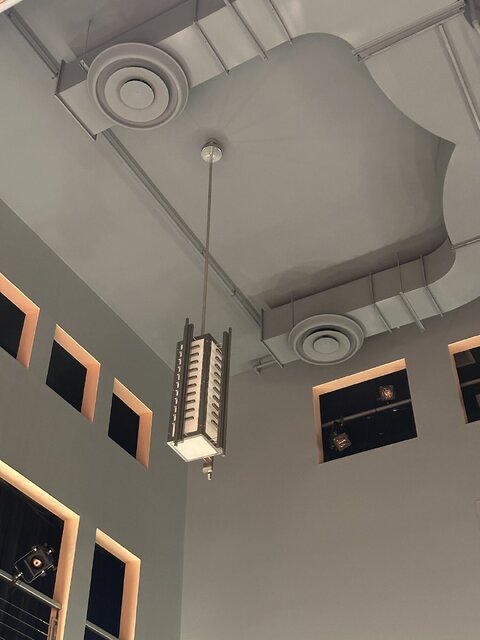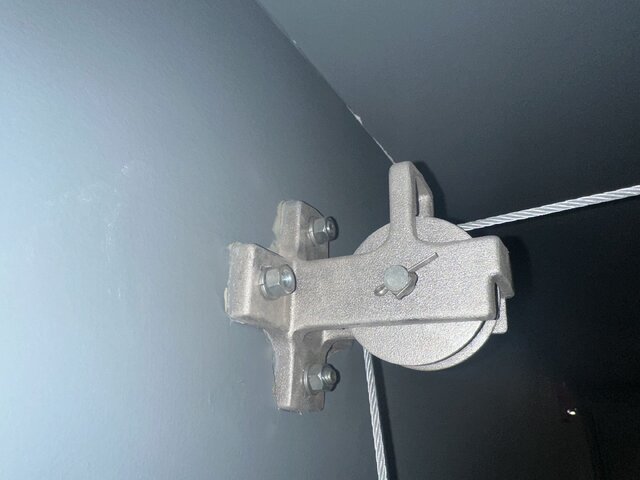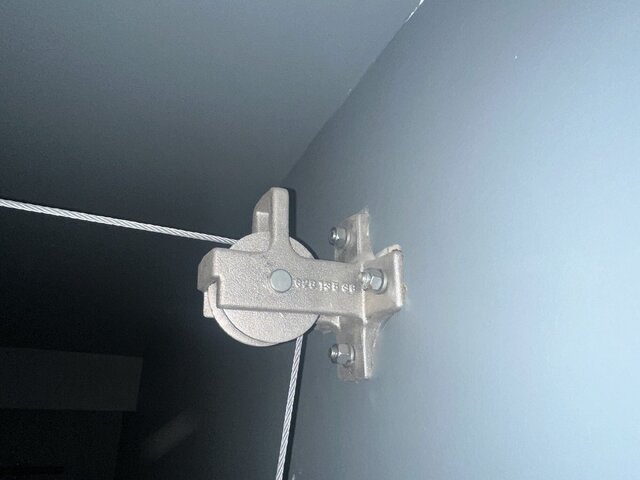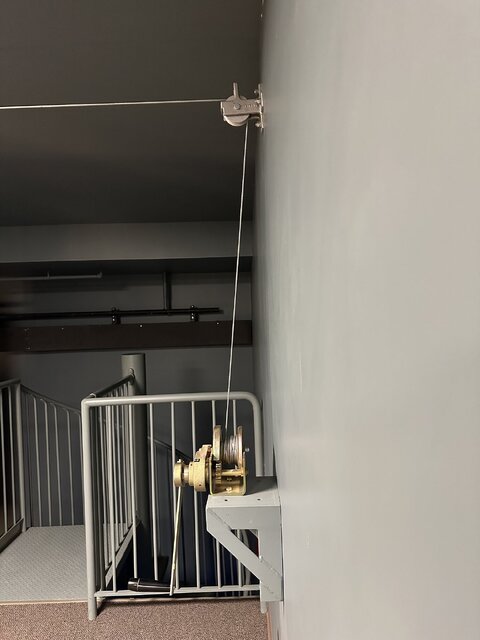TJScalzo
Member
Hi everyone, this is my first post here so I apologize if I've missed anything or should be posting this elsewhere.
I was recently hired as the "general theatre technician" (one-person department) for a high school with a good number of different venues, each with their own quirks. There hasn't been anyone in the position for a number of years, so I am now responsible for all of these spaces without any explanations of their specific technical systems. I have been getting acquainted with the spaces and discovering how everything works on my own for the past couple months.
I have just discovered that the two large pendant lights over the audience in one of the venues are each supported by a single line of wire rope attached to hand-cranked winches. When I flew them in to replace their light bulbs, I observed a couple instances of bird caging on the lines. Looking at the system as a whole, it seems at least one of the winches wasn't aligned correctly with the guide pulley above, so the wire rope has been wound around the drum unevenly for a number of years.
Based on my relatively limited rigging experience, all of these factors are cause for concern and the wire rope should be replaced at the very least. Ideally, the whole winch system would be reconsidered and/or rearranged to allow the line to wind onto the drum evenly. However, as we're nearing the end of the school year, I have been told that my department doesn't have the budget to have a vendor come in anytime soon.
I was able to submit a work order to have an electrician and a carpenter from the city come and look at it. Although they admitted that rigging wasn't their areas of expertise, they both didn't seem too concerned since there's no visible fraying or breakage. They didn't feel the need to elevate this to an emergency safety concern.
I've attached images of the bird caging as well as the winch system and pendant light.
I have always believed that being overcautious is better than someone getting hurt. I originally believed this was an emergency that needed to be fixed as soon as possible, but in this situation I'm outnumbered. I just got out of college. I'm still proving myself as a theatre professional at this school. The city employees didn't think that this was an issue, so I'm questioning my rigging knowledge and how serious of a problem this actually is.
How much of an immediate concern should this be? Does anyone have suggestions of professional riggers or rigging companies in Connecticut that could come do an inspection? If replacing this rigging system got added to a list of big budget items for next school year, would that timeline be okay?
These pendant lights will probably only have to fly up and down once every couple of years to replace their light bulbs. It's entirely possible that this was the first time they were moved in the last decade. The pendants are probably at least 400lbs each and are hanging directly over the audience. I'm in a position where I could push for the emergency removal/replacement of these pendants and their rigging, but I don't want to cause a huge fuss if it's not that serious.
I apologize for such a long post. Any advice would be much appreciated. Thank you in advance.
I was recently hired as the "general theatre technician" (one-person department) for a high school with a good number of different venues, each with their own quirks. There hasn't been anyone in the position for a number of years, so I am now responsible for all of these spaces without any explanations of their specific technical systems. I have been getting acquainted with the spaces and discovering how everything works on my own for the past couple months.
I have just discovered that the two large pendant lights over the audience in one of the venues are each supported by a single line of wire rope attached to hand-cranked winches. When I flew them in to replace their light bulbs, I observed a couple instances of bird caging on the lines. Looking at the system as a whole, it seems at least one of the winches wasn't aligned correctly with the guide pulley above, so the wire rope has been wound around the drum unevenly for a number of years.
Based on my relatively limited rigging experience, all of these factors are cause for concern and the wire rope should be replaced at the very least. Ideally, the whole winch system would be reconsidered and/or rearranged to allow the line to wind onto the drum evenly. However, as we're nearing the end of the school year, I have been told that my department doesn't have the budget to have a vendor come in anytime soon.
I was able to submit a work order to have an electrician and a carpenter from the city come and look at it. Although they admitted that rigging wasn't their areas of expertise, they both didn't seem too concerned since there's no visible fraying or breakage. They didn't feel the need to elevate this to an emergency safety concern.
I've attached images of the bird caging as well as the winch system and pendant light.
I have always believed that being overcautious is better than someone getting hurt. I originally believed this was an emergency that needed to be fixed as soon as possible, but in this situation I'm outnumbered. I just got out of college. I'm still proving myself as a theatre professional at this school. The city employees didn't think that this was an issue, so I'm questioning my rigging knowledge and how serious of a problem this actually is.
How much of an immediate concern should this be? Does anyone have suggestions of professional riggers or rigging companies in Connecticut that could come do an inspection? If replacing this rigging system got added to a list of big budget items for next school year, would that timeline be okay?
These pendant lights will probably only have to fly up and down once every couple of years to replace their light bulbs. It's entirely possible that this was the first time they were moved in the last decade. The pendants are probably at least 400lbs each and are hanging directly over the audience. I'm in a position where I could push for the emergency removal/replacement of these pendants and their rigging, but I don't want to cause a huge fuss if it's not that serious.
I apologize for such a long post. Any advice would be much appreciated. Thank you in advance.



